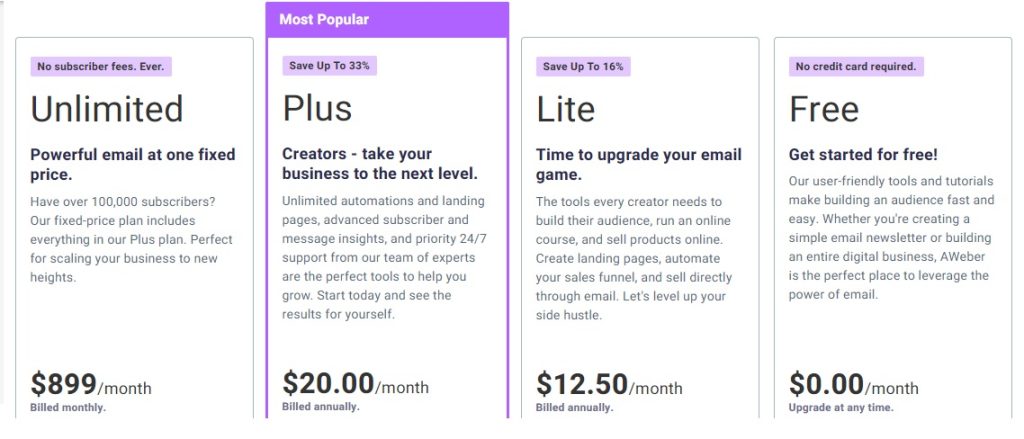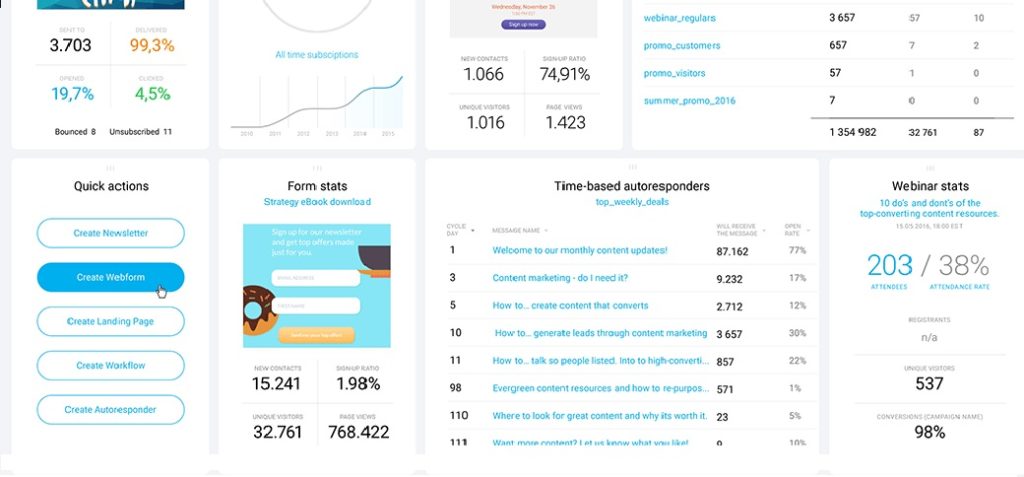Getresponse vs Aweber which one better
Selecting the right email marketing platform is a pivotal decision for businesses aiming to engage and nurture their audience effectively. In the realm of email marketing, Aweber and GetResponse stand out as prominent contenders.This article we will discuss about Getresponse vs Aweber. In this comprehensive comparison, we’ll dissect the features, strengths, and considerations of both platforms to help you make an informed choice.
1. User-Friendly Interface:
Aweber:
Aweber prides itself on a user-friendly interface, making it an ideal choice for beginners. The platform’s intuitive design and straightforward navigation streamline the email creation process. The drag-and-drop editor simplifies content creation, enabling users to craft visually appealing emails without technical hurdles.
GetResponse:
GetResponse also boasts a user-friendly interface with a clean design. The platform’s user-centric approach ensures that both beginners and seasoned marketers can navigate seamlessly. The drag-and-drop editor, akin to Aweber’s, empowers users to create compelling campaigns effortlessly.
Verdict: Aweber and GetResponse are both user-friendly, catering to users with varying levels of experience.
2. Email Automation:
Aweber:
Aweber provides robust automation features, allowing users to set up automated email sequences based on subscriber behavior. This feature is instrumental for drip campaigns, lead nurturing, and targeted communication.
GetResponse:
GetResponse is renowned for its advanced automation capabilities. The platform offers visual workflow builders, allowing users to create intricate automation sequences. This includes tagging, segmentation, and personalized communication to enhance engagement.
Verdict: GetResponse takes the lead with its more advanced and versatile automation features.
3. Integration and Compatibility:
Aweber:
Aweber integrates seamlessly with a range of third-party tools, including popular CRMs and e-commerce platforms. While the integration options are substantial, they might not match the extensive offerings of GetResponse.
GetResponse:
GetResponse excels in integration capabilities, connecting effortlessly with numerous applications and services. This flexibility is particularly advantageous for businesses with diverse tech stacks.
Verdict: GetResponse has an edge in terms of integration capabilities.
4. Pricing:
Aweber:
Aweber offers a pricing model based on the number of subscribers, with a free plan offering limited features and a 30-day free trial for premium plans.
GetResponse:
GetResponse follows a similar subscriber-based pricing model, with a free trial available. The paid plans are competitive, offering a range of features based on the subscriber tier.
Verdict: The choice between Aweber and GetResponse depends on your budget and specific feature requirements.
5. Customer Support:
Aweber:
Aweber provides excellent customer support through email, live chat, and phone. The support team is known for its responsiveness and helpfulness.
GetResponse:
GetResponse offers customer support through email and live chat. While phone support is available, it might be limited based on the plan.
Verdict: Aweber has a slight advantage with its comprehensive customer support options.
6. Analytics and Reporting:
Aweber:
Aweber provides essential analytics tools, including open rates, click-through rates, and subscriber growth. While comprehensive, the analytics might not be as detailed as GetResponse’s.
GetResponse:
GetResponse offers advanced analytics and reporting features, providing insights into subscriber behavior, engagement, and conversion metrics. The platform’s analytics tools are particularly beneficial for data-driven decision-making.
Verdict: GetResponse excels in providing in-depth analytics and reporting capabilities.
7. Templates and Design Flexibility:
Aweber:
Aweber offers a range of professionally designed templates that are customizable to align with your brand. The drag-and-drop editor simplifies the design process.
GetResponse:
GetResponse boasts a diverse template library with a high level of design flexibility. The platform’s design capabilities cater to businesses with a strong emphasis on branding.
Verdict: GetResponse offers more extensive design flexibility and template variety.
8. Deliverability:
Aweber:
Aweber maintains a reputation for high deliverability rates. The platform employs industry best practices to ensure that your emails reach subscribers’ inboxes.
GetResponse:
GetResponse is proactive in ensuring deliverability, employing anti-spam measures and monitoring to optimize email delivery.
Verdict: Both platforms are reliable in terms of email deliverability.
9. Security Features:
Aweber:
Aweber prioritizes the security of user data and communications, implementing encryption and adhering to industry standards.

GetResponse:
GetResponse follows robust security protocols to safeguard user data, providing features such as two-factor authentication.
Verdict: Both Aweber and GetResponse are committed to ensuring the security of user data.
Choosing between Aweber and GetResponse hinges on your specific business needs, budget, and growth aspirations. Aweber is an excellent choice for those seeking simplicity and ease of use, while GetResponse caters to users looking for advanced features, extensive automation, and scalability.
Before making a decision, leverage the free trials offered by both platforms to explore their features. Consider your budget, desired features, and long-term goals when selecting the email marketing platform that aligns with your unique requirements. Whether you opt for Aweber’s simplicity or GetResponse’s versatility, both platforms can be powerful allies in your email marketing endeavors.
10. Mobile Responsiveness:
Aweber:
Aweber ensures that emails created within its platform are mobile-responsive. This is crucial in the era of mobile dominance, ensuring that your email campaigns look polished and are easily readable on various devices.
GetResponse:
GetResponse also places a strong emphasis on mobile responsiveness, providing templates and tools that adapt seamlessly to different screen sizes. This is essential for reaching subscribers who primarily access their emails on smartphones and tablets.
Verdict: Both platforms prioritize mobile responsiveness, ensuring a positive user experience across devices.
11. Community and Education Resources:
Aweber:
Aweber offers a variety of educational resources, including blog posts, webinars, and guides, to help users enhance their email marketing skills. The Aweber community provides a space for users to share insights and tips.
GetResponse:
GetResponse has an extensive knowledge base, offering tutorials, guides, and a community forum. The platform also produces additional content such as podcasts and webinars, ensuring users stay informed about the latest trends and best practices.
Verdict: Both platforms provide valuable educational resources, with GetResponse offering a slightly broader knowledge base.
12. A/B Testing Capabilities:
Aweber:
Aweber allows users to conduct A/B testing on various elements, including subject lines and email content. This feature is valuable for optimizing campaigns based on subscriber preferences.
GetResponse:
GetResponse offers comprehensive A/B testing features, allowing users to experiment with different variables, such as content, send times, and more. The results can provide data-driven insights for refining future campaigns.
Verdict: GetResponse offers more advanced A/B testing options, making it suitable for users who prioritize extensive experimentation.
13. API and Developer-Friendly Features:
Aweber:
Aweber provides a RESTful API, enabling developers to integrate Aweber’s functionality into other applications. While it may not have as extensive features as GetResponse, it caters to basic integration needs.
GetResponse:
GetResponse’s API is robust and well-documented, making it suitable for developers looking to customize and extend the platform’s functionality. The extensive API capabilities contribute to GetResponse’s reputation as a developer-friendly platform.
Verdict: GetResponse is the preferred choice for users with advanced integration and customization requirements.
In the Aweber vs. GetResponse showdown, both platforms offer distinctive strengths. Aweber is a solid choice for those who appreciate simplicity and ease of use, especially beginners in the email marketing arena. Conversely, GetResponse is a versatile platform excelling in advanced features, automation capabilities, and scalability.
As you weigh your options, consider your specific needs, budget constraints, and long-term scalability. Both Aweber and GetResponse offer trial periods, allowing you to experience firsthand how each platform aligns with your business goals. Whether you opt for Aweber’s user-friendly simplicity or GetResponse’s feature-rich environment, both platforms empower businesses to leverage email marketing as a potent tool in their digital strategy.
Decoding Aweber vs. GetResponse Pricing Differences
Choosing the right email marketing platform is a pivotal decision for businesses, and when it comes to Aweber and GetResponse, understanding the nuances of their pricing structures is key. In this comprehensive comparison, we’ll delve into the pricing differences between Aweber and GetResponse to help you make an informed choice for your email marketing needs.
Aweber Pricing Overview:
Aweber adopts a straightforward pricing model based on the number of subscribers. The plans are designed to scale with your growing audience, making it accessible for businesses of all sizes.
1. Free Plan:
Aweber offers a free plan with basic features, allowing users to explore the platform before committing to a paid subscription. This is an excellent option for small businesses or those just starting with email marketing.
2. Paid Plans:
For users requiring advanced features, Aweber provides several paid plans. The pricing is tiered based on the number of subscribers, and users can choose a plan that aligns with the size of their audience.
Get best effective discount on Aweber.
GetResponse Pricing Overview:
GetResponse also follows a subscriber-based pricing model, but its plans include a broader range of features compared to Aweber. The platform offers more flexibility for users with varying needs.
1. Free Trial:
Similar to Aweber, GetResponse offers a free trial period for its premium plans. This allows users to explore the advanced features and functionalities before making a commitment.
2. Paid Plans:
GetResponse‘s paid plans are tiered based on the number of subscribers. However, each plan includes a comprehensive set of features, including advanced automation, landing pages, and webinar capabilities.
Get best effective discount on getresponse.

Key Pricing Differences:
Feature Inclusions:
- Aweber: While Aweber’s paid plans provide essential email marketing features, some advanced features may be limited in the lower-tier plans.
- GetResponse: GetResponse’s plans come with a broader set of features even in the lower tiers. This includes advanced automation, webinar hosting, and landing page creation.
Webinars:
- Aweber: Aweber does not include webinar features in its plans, focusing primarily on core email marketing functionalities.
- GetResponse: GetResponse includes webinar capabilities in its plans, making it a comprehensive choice for businesses looking to integrate webinars into their marketing strategy.
Automation:
- Aweber: Aweber provides automation features in its paid plans, but the extent of automation capabilities may not be as extensive as GetResponse’s.
- GetResponse: GetResponse is renowned for its advanced automation capabilities, offering visual workflow builders and intricate automation sequences even in its basic plans.
Landing Pages:
- Aweber: Landing pages are available in Aweber’s plans, but users may find more design flexibility and advanced options in GetResponse.
- GetResponse: GetResponse includes landing page creation tools in all its plans, providing users with the ability to design and publish landing pages without the need for additional tools.
Verdict: Making the Right Choice
Choosing between Aweber and GetResponse from a pricing perspective depends on your business’s specific needs and budget considerations.
- If you’re looking for simplicity and have a focus on core email marketing features, Aweber’s pricing model may be more aligned with your requirements.
- If you seek a comprehensive solution with advanced automation, webinar capabilities, and landing page creation, GetResponse’s pricing, although slightly higher, offers more value in terms of feature inclusions.
In conclusion, the decision between Aweber and GetResponse comes down to your business’s unique needs and priorities. Consider conducting a thorough evaluation during the free trial periods to assess which platform best suits your email marketing objectives and budget constraints. Whether you opt for Aweber’s simplicity or GetResponse’s feature-rich environment, both platforms provide robust solutions to elevate your email marketing efforts.
Aweber vs. GetResponse Pros and Cons
Selecting the right email marketing platform is a critical decision for businesses aiming to enhance their digital presence. Aweber and GetResponse, two prominent players in the field, each bring a unique set of strengths and limitations to the table. In this in-depth analysis, we’ll explore the pros and cons of both platforms to help you make an informed choice for your email marketing endeavors.
Aweber: Unveiling the Pros and Cons
Pros:
- User-Friendly Interface: Aweber excels in providing an intuitive and user-friendly interface, making it an ideal choice for beginners or those who prioritize ease of use.
- Automation Capabilities: Aweber offers robust automation features, allowing users to set up automated email sequences based on subscriber behavior, which is crucial for targeted marketing.
- Deliverability: Aweber has a strong reputation for high deliverability rates, ensuring that your emails reach subscribers’ inboxes consistently.
- Customer Support: Aweber provides excellent customer support through various channels, including email, live chat, and phone, with a responsive and helpful support team.
Cons:
- Limited Advanced Features: While suitable for beginners, Aweber may lack some of the advanced features offered by competitors, making it less appealing for businesses with complex automation needs.
- Pricing Structure: Aweber’s pricing structure, based on the number of subscribers, may become less cost-effective for businesses with rapidly growing email lists.
GetResponse: Unveiling the Pros and Cons
Pros:
- Versatile Automation: GetResponse is renowned for its advanced automation capabilities, offering intricate workflows, tagging, and segmentation even in its basic plans.
- Comprehensive Features: GetResponse provides a comprehensive set of features, including webinar hosting, landing page creation, and advanced analytics, making it suitable for businesses with diverse marketing needs.
- Webinar Capabilities: GetResponse stands out with its integrated webinar hosting, a feature not offered by many competing platforms, allowing businesses to conduct webinars seamlessly.
- Landing Page Creation: GetResponse includes landing page creation tools in all plans, offering design flexibility without the need for additional tools.
Cons:
- Learning Curve: The extensive feature set of GetResponse may lead to a steeper learning curve, making it potentially less suitable for beginners or those seeking a simpler solution.
- Slightly Higher Pricing: GetResponse’s pricing, while offering a comprehensive feature set, may be slightly higher compared to some competitors, affecting the budget considerations for some businesses.
Choosing Between Aweber and GetResponse:
Consider Aweber if:
- You’re a beginner looking for a user-friendly platform.
- Your business has straightforward automation needs.
- Cost-effectiveness is a top priority.
Consider GetResponse if:
- You require advanced automation capabilities and versatility.
- Webinars are an integral part of your marketing strategy.
- Landing page creation and additional features are crucial.
In conclusion, the choice between Aweber and GetResponse hinges on your specific business requirements, expertise level, and budget considerations. Aweber is a solid choice for simplicity and ease of use, especially for beginners. On the other hand, GetResponse offers a feature-rich environment, making it suitable for businesses with advanced marketing needs. Take advantage of the trial periods offered by both platforms to experience their features firsthand and determine which aligns best with your unique goals. Whether you opt for Aweber’s user-friendly approach or GetResponse’s versatility, both platforms provide robust solutions to elevate your email marketing strategy.






